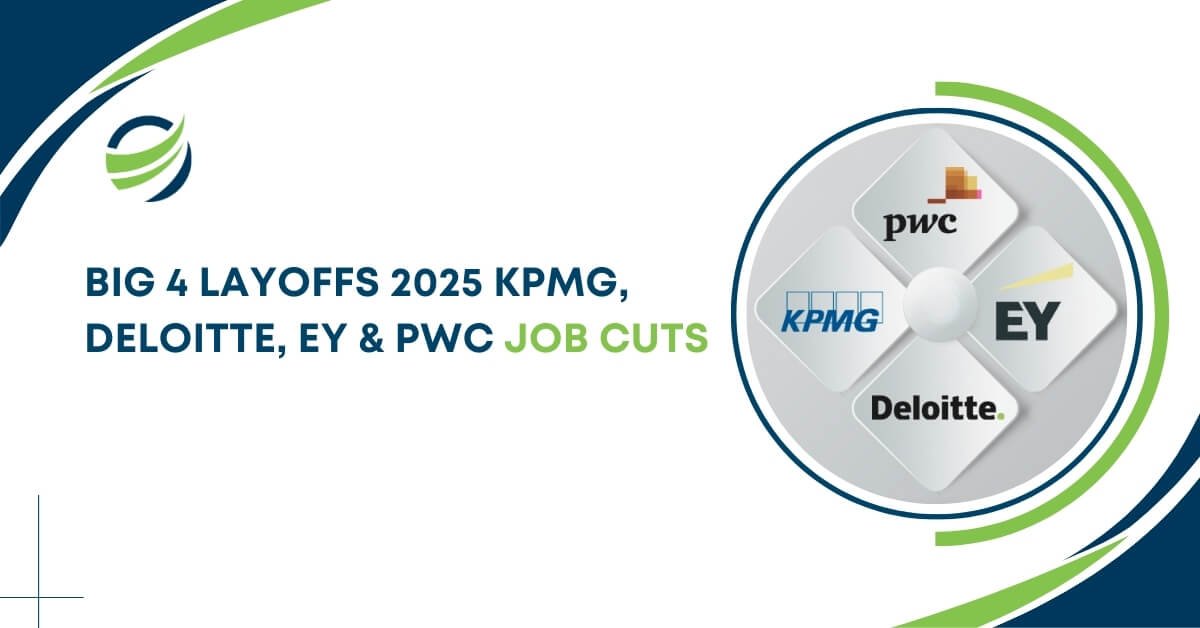The big 4 layoffs of 2025 have emerged as a defining moment for the global accounting profession. Deloitte, EY, KPMG, and PwC, collectively known as the Big Four, have each announced substantial workforce reductions in recent months of 2025.
Together, these firms employ hundreds of thousands of professionals worldwide, yet they are now navigating a complex operating environment shaped by shifting client expectations, heightened cost pressures, and broader economic uncertainty.
These developments are not isolated occurrences but part of a wider recalibration across the professional services sector. Historically low attrition rates, combined with advances in automation and artificial intelligence, are prompting the largest accounting firms to realign staffing models and redeploy resources.
In this context, the big four layoffs illustrate how even the most established market leaders must adapt quickly to safeguard long-term competitiveness and operational efficiency.
Detailed Breakdown of Big Four Layoffs
PwC Layoffs 2025
In May 2025, Price waterhouse Coopers (PwC) initiated a significant workforce reduction, cutting approximately 1,500 positions across its U.S. operations, equivalent to 2% of its 75,000-person workforce.
The majority of the affected roles were in the audit and tax divisions, with the firm citing historically low employee turnover as a key factor in creating staffing surpluses. This decision followed a period of strategic review aimed at aligning headcount with client demand, operational efficiency goals, and future growth priorities.
Less than a year earlier, in September 2024, PwC announced the elimination of approximately 1,800 jobs, or 2.5% of its U.S. workforce. That downsizing, the first of its scale since 2009, spanned multiple levels, from entry-level associates to managing directors, and impacted nearly half of its offshore roles.
Taken together, the PwC layoffs 2025 and the prior reductions reflect the firm’s proactive approach to recalibrating its workforce in response to shifting market conditions and industry transformation.

PwC Layoffs – Key Takeaways:
- Two consecutive cuts: Nearly 3,300 roles eliminated between September 2024 and May 2025.
- First major reduction in over a decade: September 2024 marked the first large-scale headcount cut since the 2009 financial crisis.
- Low attrition challenge: Unusually low voluntary turnover disrupted the firm’s natural workforce cycle.
- Focus on efficiency: Layoffs concentrated in areas where automation and restructuring could deliver greater cost savings.
KPMG’s Audit Workforce Cuts
In November 2024, KPMG announced plans to lay off approximately 330 employees, representing nearly 4% of its U.S. audit workforce of about 9,000 professionals.
The decision was largely attributed to unusually low voluntary turnover, which led to an oversupply of staff in certain service lines. This move underscores the challenges faced by professional services firms in balancing staffing levels with fluctuating market demand, particularly when attrition trends shift.
The firm framed the KPMG layoffs as part of a broader strategy to align its workforce size, skill mix, and geographic footprint with current and anticipated business needs.
While KPMG has not disclosed the specific locations most affected, industry observers note that such workforce adjustments are often driven by evolving client demands, cost management priorities, and the integration of technology into audit processes.
Key Details on KPMG’s Layoffs:
- Scale of cuts: Approximately 330 audit positions have been eliminated, representing about 4% of the U.S. workforce. Audit workforce (~9,000 employees).
- Who’s affected: Primarily associates and junior managers; senior partners remain unaffected.
- Reason: Exceptionally low attrition rates, staffing levels had swelled during the pandemic, and fewer voluntary departures created surplus capacity.
- Financial backdrop: The U.S. audit division generated $3.7 billion in revenue in 2023, a 6% increase from the previous year, indicating that the layoffs were not driven by falling revenues.
- Industry context: While other Big Four cuts targeted advisory teams, KPMG’s move stands out for trimming audit roles despite strong business performance.
Deloitte UK’s Advisory Business Reductions
Deloitte layoffs 2025 in the UK have made headlines, with up to 180 roles at risk within its advisory business.
The firm cited a continued slowdown in the demand for consulting services, as corporate clients increasingly prioritise cost optimisation over expansive transformation projects.
These reductions follow previous workforce adjustments: in October 2024, Deloitte placed up to 250 jobs at risk, and in September 2024, as many as 800 roles, primarily in the consulting division, were flagged for possible cuts.
Together, these moves highlight Deloitte’s strategic push to maintain profitability while adapting to softer market conditions in the UK consulting sector.
Key Insights into Deloitte’s Advisory Cuts:
- Roles affected: Up to 180 positions within the advisory division were impacted by the cuts.
- Prior reductions: October 2024 (≈250 jobs at risk) and September 2024 (≈800 jobs at risk).
- Cause: Sluggish demand for large-scale consultancy projects.
- Sector impact: Reflects a broader slowdown across major consultancy firms in the UK
EY Reshapes Global Workforce Amid Market Shifts
In line with other accounting layoffs 2025, EY layoffs have been implemented across multiple regions to adapt to evolving market conditions and shifting client priorities. While the exact numbers vary by location, the initiative is part of a global restructuring aimed at increasing operational efficiency and focusing resources on high-growth service lines.
This strategic pivot aligns with trends in the consulting market, where many clients are scaling back discretionary spending on large-scale projects. EY has been reallocating resources toward areas like sustainability consulting, technology integration, and regulatory compliance to capture emerging opportunities and offset declines in more traditional advisory work.

Industry-Wide Trends in Professional Services
The Big 4 layoffs are part of a broader transformation within the professional services industry. Economic headwinds, changing client expectations, and rising operational costs are prompting firms to reassess talent deployment and service delivery models.
Increased automation, AI integration, and shifting demand patterns are reshaping the skill sets needed across audit, tax, and advisory divisions.
The Big Four, employing hundreds of thousands globally, are leading this recalibration. By streamlining structures, investing in specialised talent, and targeting high-margin service lines, they aim to remain agile and competitive in a challenging business environment.
How Firms Can Prevent Future Workforce Disruption
Strategic Workforce Planning: Identify critical skills needed for the future and align hiring and training strategies accordingly.
Upskilling & Reskilling: Invest in continuous learning programs to equip employees with emerging skills like automation, data analytics, and ESG reporting.
Flexible Staffing Models: Use hybrid teams, contract staff, or project-based roles to manage workload fluctuations without large-scale layoffs.
Transparent Communication: Keep employees informed about business changes and workforce strategies to build trust and reduce uncertainty.
Employee Well-being Initiatives: Focus on mental health, engagement, and retention strategies to maintain morale during challenging periods.
Talent Diversification: Encourage cross-functional experience and career mobility to create a more adaptable workforce.
Conclusion
The recent wave of Big Four layoffs in 2025 underscores the fast-changing nature of the accounting profession. From the PwC layoffs 2025 to the Deloitte layoffs 2025, KPMG layoffs, and ey layoffs, these workforce adjustments reveal how even the largest market players must adapt to stay relevant.
As the industry continues to evolve, those firms that align their talent strategies with emerging market opportunities, embrace innovation, and enhance operational efficiency will be best positioned to succeed.



